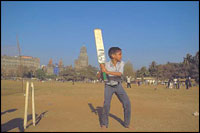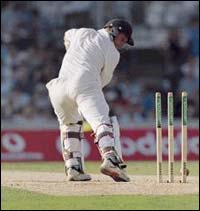 January 31, 2002
January 31, 2002
Cricket in a different league
- Jonathan Dyson
It may be due to a sub-conscious superiority complex, a colonial hangover from the days when India was part of the British Empire, or perhaps just sheer ignorance, but the sad fact is that in England, the accepted image of Indian cricket is one of chaos.
Impassioned boys running round the maidans, playing cricket night and day in the streets, and then graduating to the Test team in spite of rather than because of the system: this has been the typical portrayal of Indian cricket in England.
Of course some of these images convey the truth about the passion in Indian cricket. However, as I have gradually come to realise, Indian cricket at grassroots and domestic level is not only far more organised and competitive than most English people seem to believe, but the game here is in many ways light years ahead of the infrastructure currently in place in England.
Already, for instance, I have discovered the fundamental difference in the attitude of English and Indian domestic players, which I first tasted in my unforgettable encounter with Bishan Bedi and his squad at Delhi, and also the schools cricket of Mumbai, which quite simply exists in a different world from the English school scene.
And the more cricket I watch here, and the more players and coaches I talk to, the more I realise just how false the image of Indian cricket that exists in England really is. As regular readers will know, I have spent the last few days in Madras. This is home to arguably the most organised and fiercely contested cricket in India.
Its club scene is of an incredibly high standard, and is organised with unfailing efficiency. The league in Madras is split into five divisions, with the first division acting as a direct feeder of players to the Tamil Nadu state team. It is organised on a professional basis, with each of the twelve teams playing a two-day game each week.
 The other four divisions, which comprise 30 teams
each, play a 50 overs per side match every Sunday, and
the top two teams and bottom two teams are promoted
and relegated at the end of the season.
The other four divisions, which comprise 30 teams
each, play a 50 overs per side match every Sunday, and
the top two teams and bottom two teams are promoted
and relegated at the end of the season.
Club cricket here has the added advantage of more space than, say, Mumbai, where the maidans are covered in club matches, with the outfields constantly overlapping each other. Around forty-five grounds are used for club matches in Madras. Most of these belong to schools and colleges, although major corporations such as Indian Cements, Indian Pistons and SPIC maintain several of the grounds.
Such a well-administered league naturally leads to a highly competitive form of cricket, with teams always playing in the knowledge that they are performing in a competition that commands respect. The first division in particular is closely followed, and regularly attracts large crowds.
On Sunday, my host in Madras, Mahadevan, took me to the ground at the College of Engineering Guindy. Two matches were being played, one in the fourth division and one in the fifth. In many ways, the best way to judge the standard of a league is to observe such games in the lower divisions, as this indicates its true depth.
And I must admit I was astonished by the cricket being played even in these lower division matches. One moment in particular took the eye. In the fourth division match, a rapid right-arm bowler came steaming in, and delivered an awkward delivery just short of a length outside the off stump.
The left-handed batsman, clearly finding that no easy runs were on offer, played an uppish cover drive, only to see the bat take a thick edge towards third man, where the fielder came surging in and dived forwards at full stretch to take a stunning catch.
I stood open-mouthed, admiring such a thrilling piece of cricket. My companion, however, expressed little surprise, and explained to me that such moments are typical of Madras league cricket. As I could see, runs are obviously hard-earned, and fielding sides perform with immense discipline.
And such is the standard of club cricket here that a separate competition called the Blue Star League is arranged for players not good enough for the real league cricket. This is also well-organised, with three divisions and enough flexibility to accept quite simply as many teams as there are who want to play.
Another highly impressive aspect of Madras cricket are the numerous academies dotted around the city. About fifteen of these exist, catering for all age groups.
Early on Sunday morning, Mahadevan took me to the Chennai St Bede's Sports Foundation (CSSF). This is a cricket academy that provides coaching for boys from the under-ten age group right through to the under-19s.
Like the league cricket, the academy is meticulously organised, with regular coaching sessions available from June through till February, and then a summer camp in April and May, featuring several practice matches. All the coaches have played first division cricket, and when I visited on Sunday, there was a coach in each of the eight nets being used.
What struck me first was the astonishingly early start to proceedings. We arrived around 7.45 am, when the morning's session was almost over. I soon discovered that the session had actually started at 5.30 am, and would finish at 8.30 am.
This schedule applies to all the age groups, and even those pupils who have to travel from another part of the city. So some had arisen at 4.00 am. I found this hard to get my head around, since most eighteen-year-olds in England are more likely to be going to bed at that time on a Sunday morning than actually getting up.
I spoke to two of the coaches involved, Vijay Kumar and Palani, to tell me a little more about the academy. I was particularly keen to find out if many boys arrived late. "No, not at all," Kumar replied. "In fact they're quite happy to arrive early."
Kumar went on to explain the exact nature of the coaching. "We always start with some physical training, including running and strenuous exercises. Then we do some intense fielding practice. This is followed by coaching the boys the basics and finer aspects of batting and bowling."
The fact that there is always a coach in each net means that any problem in a player's technique is spotted and worked on immediately. I saw one coach teaching a batsman how to use his feet, about the importance of getting forward and yet still being able to rock back for the short ball.
 I was particularly curious about this aspect of
coaching, since footwork is a facet of coaching sadly
lacking in England. Even Mike Atherton admitted that
he was never coached about feet movement in his entire
career.
I was particularly curious about this aspect of
coaching, since footwork is a facet of coaching sadly
lacking in England. Even Mike Atherton admitted that
he was never coached about feet movement in his entire
career.
But what impressed me most about the academy was its resourcefulness. Not only does it make maximum use of the cool mornings, and of the relatively limited space available, but also cleverly makes up for the lack of money at its disposal, compared with some of the academies in other Test-playing countries.
As Palani explained: "We can't afford the video equipment they have in Australia and South Africa. But we make up for that by encouraging the younger players to watch their seniors, in the nets and in matches, and to learn from them. That way, they come to appreciate the finer aspects of the game, right down to little things like the sound a bat makes when a shot is timed sweetly."
As I have discovered over the past few weeks, for this ingenious way of using its resources, for its sophistication and its organisation, CSSF is a typical example of the committed and well-structured work that takes place in several areas of Indian grassroots cricket. It's just a shame that, within the cricketing world, such work remains a dark secret.
GE Features
©1996 to 2001 rediff.com India Limited. All Rights Reserved.